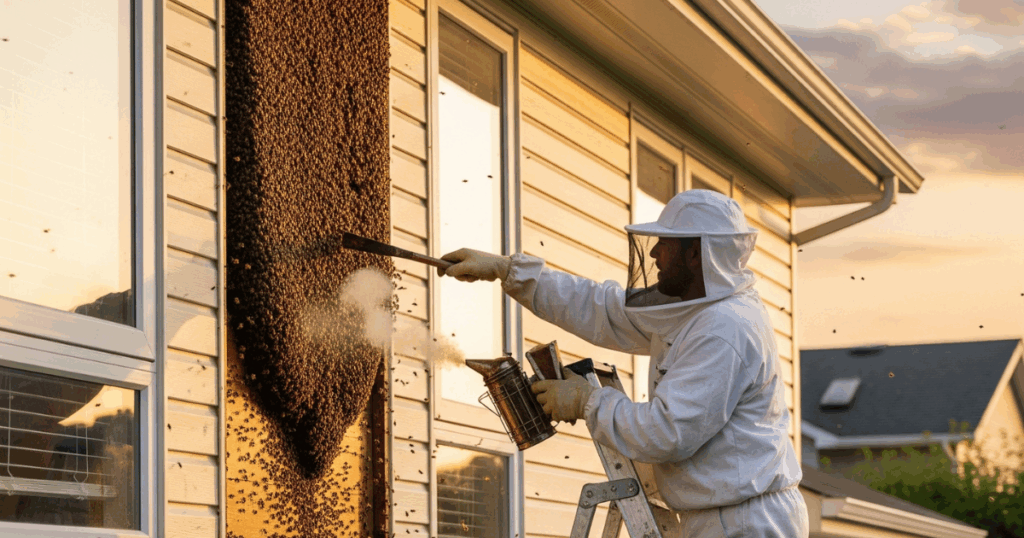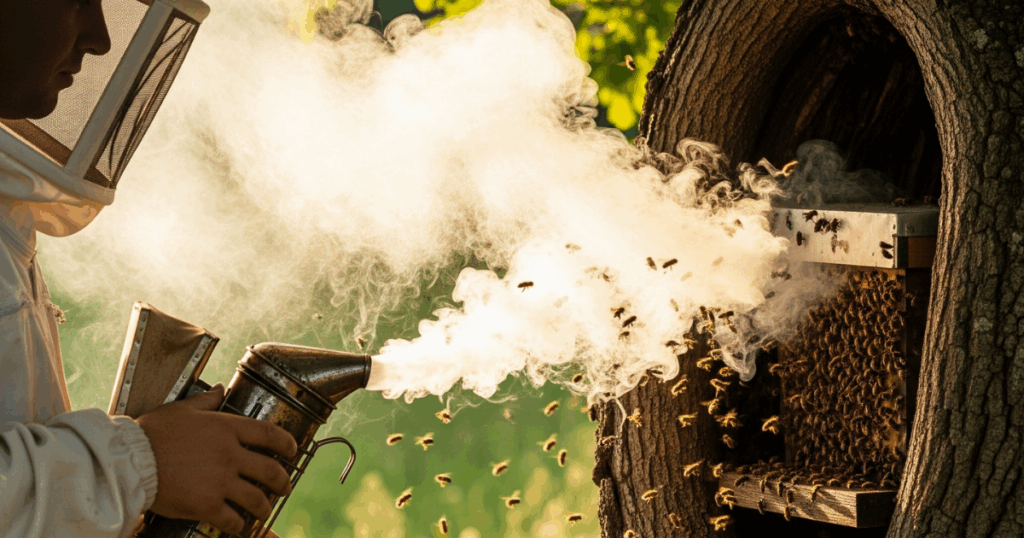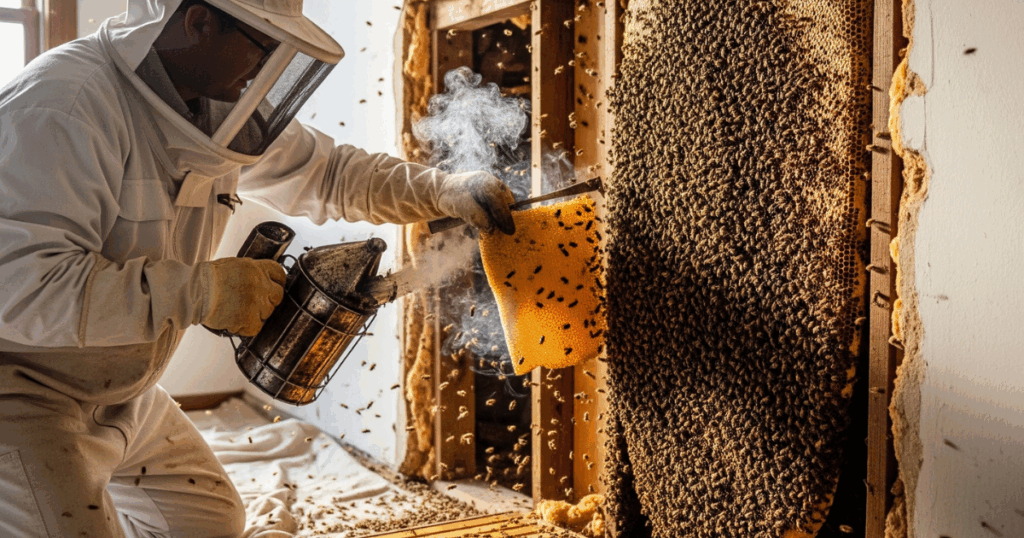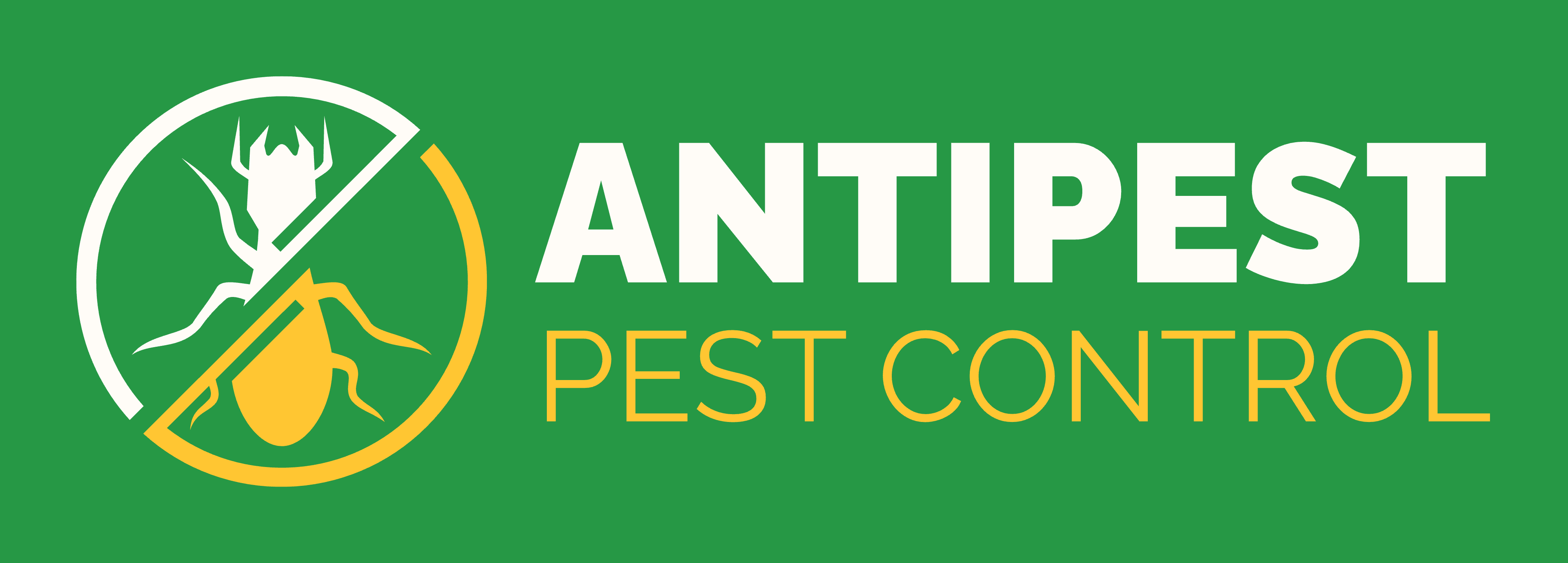Honey bees play an indispensable role in pollination and food production, yet their presence in or around our homes can become a major concern. If you’ve discovered a hive in your backyard, bees persistently entering your kitchen, or buzzing in your walls, you probably want to know how to get rid of honey bees safely and effectively. The challenge intensifies if someone in your family is allergic to stings, increasing the urgency of responding quickly but thoughtfully.
In this guide, we’ll explore how to get rid of honey bees from home using practical, humane techniques. We’ll also cover when to call professionals, how to prevent future infestations, and how to stay safe during the process. Let’s dive into the best methods to tackle this buzzing issue, without causing harm to these pollinators or to yourself.
Table of Contents
Understanding Honey Bees: Why Removal Requires Caution?
While honey bees can be a nuisance in and around your home, eliminating them isn’t straight forward, or always recommended. Bees are vital pollinators and their populations are under threat globally. Their decline can disrupt natural ecosystems and food supplies. Beyond environmental concerns, improper DIY removal attempts can provoke aggressive swarms, resulting in stings or even structural damage if the colony is inside a wall.
How to Get Rid of Honey Bees at Home? – 5 Effective and Simple Steps

When honey bees establish themselves close to human habitats, it’s crucial to resolve the situation promptly and ethically. How to get rid of honey bees at home while prioritizing safety and environmental responsibility.
Step 1. Assess and Observe
When learning how to get rid of honey bees, the first step is to identify the hive location by observing the bees’ flight patterns to find their entry point and nesting spot. It is crucial to maintain a safe distance and avoid disturbing the bees unnecessarily, as they can become defensive and aggressive when threatened.
Additionally, alert all household members about the presence of bees and restrict access to the affected area to ensure the safety of everyone, especially those with allergies. Taking these precautions sets the foundation for a safe and effective approach to how to get rid of honey bees from your property.
Step 2. Avoid Harmful Chemicals
When considering how to get rid of honey bees, it is important to avoid using harmful chemicals or commercial insecticides that are not approved for bees. Many sprays and traps can damage the colony, disrupt the surrounding ecosystem, and may even be illegal to use. Instead, opt for safe and environmentally friendly removal methods that minimize harm to the bees and preserve their vital role in pollination. Always prioritize non-toxic approaches or seek professional help to remove bees safely and responsibly.
Step 3. Use Smoke as a Humane Deterrent

Smoke is widely regarded as the most effective and humane way to gently encourage honey bees to move on without harming them. Bees sense smoke as a warning of fire, prompting them to leave and find a safer nesting place.
How to Apply:
- Put on full protective gear (bee suit, gloves, veil) to avoid stings.
- Light a bee smoker or create smoke using damp cardboard and firewood directly below the hive.
- Allow the smoke to drift gradually toward the hive, never directly blasting the entrance.
- Move away as the bees become agitated.
Only attempt this for small colonies outside the home. For large or indoor hives, call a professional.
Step 4. Deploy Natural Repellents

Some natural remedies can help nudge honey bees to relocate. These solutions work best for small invasions or swarms near your home rather than entrenched hives.
| Natural Repellent | How to Use | Best For |
| Garlic Spray | Crush garlic, mix with water, spray entrance and surroundings | Outdoor hives, entry points |
| Citronella | Burn citronella candles near the hive for several days | Covered patios, porches |
| Vinegar Solution | Mix 1 part vinegar with 3 parts water, spray nearby,but note: vinegar can kill bees, so use only as a last resort and with caution | Emergency only |
| Peppermint Oil | Dilute oil, apply to cotton balls near hive or nesting area | Outdoor corners, wall gaps |
| Cinnamon | Sprinkle powdered cinnamon where bees are active | Windowsills, ground hives |
Natural repellents are best used as part of an early intervention strategy, not for removing well-established nests.
Discover safe and effective ways on How to Get rid of sand wasps from your yard – read the full guide here.
Step 5. Offer an Attractive Alternative
When trying to learn how to get rid of honey bees, setting up sweet-smelling fruit like sliced mango or pear about 20–30 feet away from the hive can help lure the bees away from your home. By gradually moving the fruit a little further each day, you encourage the bee colony to relocate comfortably and safely away from your living area.
This gentle tactic attracts bees without harming them, promoting a natural migration that reduces the risk of confrontation and protects both your household and the bees. Using this method complements other safe removal practices for effective hive relocation.
How to Get Rid of Honey Bees from Your Walls?

When bees nest in wall voids, the challenge becomes much more technical. Attempting to spray or block entrances can backfire, sealed bees may force their way into living areas or leave behind decomposing honey and wax, creating lasting odor and insect problems.
How to Get Rid of Honey Bees in Your Walls?
- Locate the Hive: Watch for bee activity and listen for buzzing behind walls.
- Don’t Seal Entry Until Bees Are Gone: Blocking entries traps the colony, risking more damage.
- Use Smoke and Sound: Smoke gently near the entrance, or tap lightly on walls to encourage bees to leave (works only with small, new hives).
- Contact Professionals: For established colonies, especially in structural cavities, always consult a local beekeeper or pest control expert trained in bee rescue and hive removal.
- Remove All Hive Material: After bees vacate, the wall should be opened, all comb and honey extracted, and the area cleaned and repaired.
- Seal and Restore: Close any access points with durable materials to prevent re-entry.
| Step | Reason | DIY/Professional |
| Locate hive | Accurate removal, minimize structural damage | Both |
| Smoke/tap to encourage exit | Safe for fresh or minor colonies | DIY |
| Full hive extraction/cleanup | Prevent rot, pests, odors | Professional |
| Seal and repair | Prevent new colonies | Both |
Professional involvement is highly recommended when honey bees infiltrate a wall or roof. This ensures safety, thorough removal, and humane treatment.
How to Get Rid of Honey Bee Hive or Nest?
How to get rid of honey bee hive or nest safely and effectively, it’s best to approach the situation with care to avoid harming the bees or yourself. One of the most common and humane methods is using smoke, which calms the bees and encourages them to leave the hive without aggression. Another approach is to contact a professional beekeeper who can carefully remove and relocate the hive intact. If immediate removal is needed, spraying a soapy water solution in the evening when bees are less active can be somewhat effective but carries risk. Always avoid harmful chemicals that could damage the environment or kill the bees unnecessarily.
Whether you’re facing a hive on a tree branch, shed, balcony, or under eaves, the ultimate goal is to relocate, not exterminate, the bees.
How to Remove a Honey Bee Hive Responsibly?
- Wear protective clothing.
- Ensure all bystanders and pets are clear of the area.
- Plan removal for evening or early morning when bees are less active.
Removal Methods:
- Smoke Method: Apply smoke regularly for a few days to encourage relocation.
- Sweet Lures: Attract bees away using fruit or sugar water set at a distance.
- Natural Repellents: Hang peppermint oil-scented cotton, citronella candles, or garlic sachets nearby.
- Physical Hive Removal: Gently cut the hive from its anchor and place in a bee box for transport (if qualified and equipped).
Common Locations and Best Hive Removal Practices
| Hive Location | Recommended Removal | DIY Possible? | Notes |
| Tree/Bush | Smoke and attractant, cut hive | Yes, with safety | Evening is best |
| Wall/Attic | Professional extraction | No | Needs structural repair/cleanup |
| Shed/Garage | Smoke, attractant, remove hive | Often | Seal any re-entry points |
| Balcony/Eaves | Smoke, attractant, physical removal | Sometimes | Use caution, protect your eyes |
After removing a hive, clean the area thoroughly with soapy water and consider spraying with peppermint oil to discourage re-nesting.
Never attempt to destroy a hive with insecticides unless absolutely necessary,and always check local regulations and environmental advice first.
How to Get Rid of Honey Bees Without Harming Them?
The decline in bee populations makes ethical removal practices essential. Here’s how you can practice safe, non-lethal removal:
- Contact a Local Beekeeper: Many beekeepers will remove swarms or hives for free or a nominal fee, especially if honey extraction is possible.
- Opt for Smoke and Natural Dissuasion: Smoke and scents like peppermint, citronella, and garlic can gently nudge bees to relocate without fatalities.
- Relocation, Not Extermination: Physically relocating a hive is best done by experts who can transfer a living colony to new, safe surroundings.
- Vacuum Removal: Professionals sometimes use specialized bee vacuums that gently collect bees for relocation.
- Avoid Traps, Poisons, or Sealing Bees In: These methods either kill bees directly or risk enough harm to be discouraged.
Ethical Bee Removal Checklist
| Action | Bee-Friendly? | DIY Possible? |
| Call a beekeeper for removal | Yes | Yes |
| Use smoke and lures | Yes | Yes |
| Apply strong scented natural repellents | Yes | Yes |
| Insecticides/bug sprays | No | No |
| Blocking entrances with bees inside | No | No |
When in doubt, prioritize how to get rid of honey bees without harming them with professional assistance.
How to Get Rid of a Honey Bee Sting: Immediate First Aid?
If you or someone is stung by a honey bee, follow immediate first-aid steps for fast relief and a lower risk of adverse reactions.
Step-by-Step: How to Get Rid of Honey Bee Sting
- Remove the Stinger: Use a blunt object like a credit card to gently scrape the stinger away,don’t pinch it, as that can inject more venom.
- Clean the Area: Wash with soap and water.
- Apply a Cold Pack: This reduces pain and swelling.
- Soothe the Sting: Apply a paste made from baking soda and water or calamine lotion.
- Monitor for Allergic Reactions: Watch for difficulty breathing, swelling of the face or throat, dizziness, or rapid heartbeat. Seek immediate help for severe reactions.
| Symptom | Action |
| Mild swelling, pain | Cold compress, cream |
| Persistent itching | Antihistamine |
| Severe allergic symptoms | Emergency attention |
Allergic reactions to honey bee stings are rare but can be fatal. Always seek medical help if you suspect a reaction.
How to Prevent Future Honey Bee Problems at Home?
To prevent future honey bee problems at home, regularly inspect your property for small openings and seal any cracks or holes where bees could enter. Keep vents, chimneys, and water meter boxes properly covered with fine mesh screens to block access. Remove potential nesting sites like debris or hollow structures, and maintain your yard to reduce attractants. If you spot a colony, contact a professional beekeeper for safe removal rather than trying to handle it yourself. After successfully removing bees, take steps to prevent them from returning.
Prevention Checklist
- Seal cracks and gaps in walls, eaves, and around windows.
- Remove old honeycombs and clean affected spaces with soapy water.
- Use natural bee deterrents like peppermint oil or mothballs in at-risk areas.
- Regularly inspect your property for new bee activity, especially during spring.
- Plant bee-attracting flowers at a distance, away from living areas, to encourage bees to nest elsewhere.
“Looking for safe solutions on how to get rid of caterpillars? Try these proven tips and reclaim your garden!”
Conclusion
Dealing with honey bees around the home, in your walls, or forming a hive on your property can be stressful, but a measured, informed approach will keep you, your family, and the bees safe. Use smoke, natural repellents, and physical removals as the primary strategies. For large infestations or hidden hives, rely on local beekeeping experts for humane, environmentally conscious help.
Visit us at the Antipest Office. Our trained technicians use safe and effective methods to protect your home and business. For service bookings and consultations, call us at +91 9819018398 .
How to Get Rid of Honey Bees? – FAQs
What’s the safest way to how to get rid of honey bees at home?
The safest way is to contact a local beekeeper or professional remover, or use smoke to gently encourage bees to move without harm.
How to get rid of honey bees hive from my property?
Wear protective gear, use smoke to move the bees, then carefully cut and relocate the hive; for large or hidden hives, seek professional help.
How to get rid of honey bees sting safely?
Scrape out the stinger gently, wash the area, use a cold pack, apply soothing cream, and seek medical attention for severe reactions.
What are some ways to how to get rid of honey bees without killing them?
Use smoke, natural repellents like peppermint or citronella, or set up sweet lures to encourage bees to relocate; call a beekeeper if needed.
How how to get rid of honey bees from my walls?
Locate the hive, avoid blocking entry, use smoke to encourage bees to leave, and have a professional remove the hive and clean the space.
How to get rid of honey bees without harming them?
Prioritize smoke, sweet lures, or calling a professional who can relocate the colony intact; avoid insecticides or closing entry points with bees inside.
What natural repellents help get rid of honey bees from home?
Garlic spray, citronella candles, peppermint oil, and mothballs can deter bees, but work best for small, new colonies or swarms.
What steps can I take to how to get rid of honey bees nest?
Go for smoke, natural scents, and physical removal if safe; always wear protection and, for bigger nests, call a bee expert.
How to get rid of honey bees from returning after removal?
Clean the area thoroughly, seal all possible entry points, apply natural repellents, and monitor regularly for new activity.
Why shouldn’t I use insecticides to get rid of honey bees?
Insecticides are harmful to bees, illegal in many locations, and can cause environmental damage, use them only if absolutely necessary and always as a last resort.

